| Toxotidae (Archerfishes) |
| 30 cm TL (male/unsexed) |
|
pelagic-neritic; freshwater; brackish, amphidromous |
| Asia and Oceania: India eastward to the Philippines, and south to Indonesia, Vanuatu, Solomon Islands, Papua New Guinea, and northern Australia. |
|
Dorsal spines (total): 4-4; Dorsal soft rays (total): 11-13; Anal spines: 3-3; Anal soft rays: 15-17. Description: Body silver or white, dorsal vertical stripes broad black four, or patches; head band black or grey at preopercle level. Body depth 2.1-2.4 in SL. Dorsal 3rd spine 1.7-1.9 in HL, longest. Scale horizontal rows 3-4 above LL, 8-9 below LL. |
| Occurs primarily in brackish mangrove estuaries, but also penetrates rivers and small streams (Ref. 4833, 44894). Reported to occur near overhanging vegetation on reefs (Ref. 9710, 48636). Usually in small aggregations (Ref. 48635). Feeds at the surface during daytime on floating debris which includes insects and vegetable matter. It is renowned for its ability to 'shoot down' insect prey by expelling beads of water from its mouth with considerable force and for its remarkable ability to compensate for visual refraction when aiming its shoots; shooting range is about 150 cm (Ref. 2847, 55339). Sold fresh in markets. |
|
Least Concern (LC); Date assessed: 16 September 2011 Ref. (130435)
|
| harmless |
Source and more info: www.fishbase.org. For personal, classroom, and other internal use only. Not for publication.

